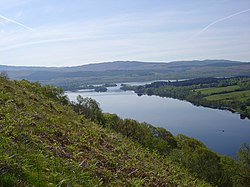Lochawe
| Loch Awe | |
|---|---|

Loch Awe, Argyll & Bute
|
|
| Location | Argyll and Bute, Scotland |
| Coordinates | 56°17′52″N 5°14′06″W / 56.29778°N 5.23500°WCoordinates: 56°17′52″N 5°14′06″W / 56.29778°N 5.23500°W |
| Type | freshwater loch |
| Primary inflows | River Orchy, Kames River |
| Primary outflows | River Awe |
| Catchment area | 840 km2 (320 sq mi) |
| Basin countries | Scotland |
| Max. length | 41 km (25 mi) |
| Max. width | 1 km (0.62 mi) |
| Surface area | 38.5 km2 (14.9 sq mi) |
| Average depth | 32 m (105 ft) |
| Max. depth | 93.6 m (307 ft) |
| Water volume | 1.2 km3 (0.29 cu mi) |
| Residence time | 0.7 year |
| Shore length1 | 129 km (80 mi) |
| Surface elevation | 36.2 m (119 ft) |
| Islands | Innis Chonnell, Inishail, Innis Chonan |
| Settlements | Lochawe |
| 1 Shore length is not a well-defined measure. | |
Loch Awe (Scottish Gaelic: Loch Obha) is a large body of freshwater in Argyll and Bute, Scottish Highlands. It has also given its name to a village on its banks, variously known as Loch Awe, or Lochawe. There are islands within the loch such as Innis Chonnell and Inishail.
It is the third largest freshwater loch in Scotland with a surface area of 38.5 square kilometres (14.9 sq mi). It is the longest freshwater loch in Scotland, measuring 41 kilometres (25 mi) from end to end with an average width of 1-kilometre (0.62 mi). The loch runs approximately south-west to north-east, roughly parallel to the two sea lochs of Loch Etive and Loch Fyne. Via the River Awe and Loch Etive it drains westward from its northern end and thus into the Atlantic Ocean. At the narrowest section of the loch are North Port (Taychreggan Hotel) and South Port (Portsonachan Hotel). Once used by cattle drovers, a ferry ran between these shores to facilitate crossing to markets beyond. The Transatlantic Cable, which runs through the village of Kilchrenan, was laid across at this point in 1955.
Loch Awe is the site of two hydroelectric projects. One is a conventional turbine power station, created by damming the River Awe in the Pass of Brander, feeding the water through underground pipes, and generating electricity as it flows into Loch Etive.
The second is a more unusual pumped storage project, using a man-made loch in the hills above the loch; water is pumped up during times of surplus power, and used to power generators at times of peak demand. The second project, known as Cruachan Dam from the name of the hill above, has a visitor centre, which includes tours into the heart of the mountain.
Loch Awe is renowned for its trout fishing. Salmon pass through the loch, coming past the barrage in the River Awe and continuing into the River Orchy. Loch Awe contains several ruined castles on islands, and at the northern end has one of the most photographed castles in Scotland, Kilchurn Castle, which in summer may be visited by a short boat trip or by a half mile walk from a small car park just after the bridge over the River Orchy. Saint Conan's Kirk and Chapel of St Fyndoca are located in Loch Awe.
...
Wikipedia

